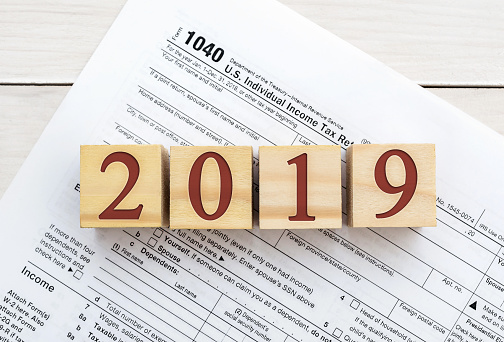The tax code gets a bit of an overhaul each year, and with the changes, it can get confusing. No worries, though; we’ll walk you through everything you need to know for 2019.
Most amendments to the tax code will only begin to affect taxpayers in April 2019. However, some of the changes can impact the financial choices you make this year. Learning about these changes early in the year will help you make the best decisions possible.
Read on to learn about the most important changes to the tax code for 2019.
Changes to the amounts taxed for each income bracket.
The 7 tax income brackets are unchanged at 10%, 12%, 22%, 24%, 32%, 35% and 37%. However, the amount each bracket is taxed has changed.
Here are the new rates for taxpayers filing as individuals.
|
Taxable Income Bracket |
Tax Due |
|
| 10% | $0 – $9,700 | 10% of taxable income |
| 12% | $9,701 – $39,475 | $970 + 12% of income over $9,700 |
| 22% | $39,476 – $84,200 | $4,543 + 22% of income over $39,475 |
| 24% | $84,201 – $160,725 | $14,382.50 + 24% of income over $84,200 |
| 32% | $160,726 – $204,101 | $32,748.50 + 32% of income over $160,725 |
| 35% | $204,101 – $510,300 | $46,628.50 + 35% of income over $204,100 |
| 37% | $510,301 and up | $153,798.50 + 37% of income over $510,300 |
Taxable income rates vary for couples filing jointly and for individuals filing as heads of households.
Changes in standard deduction amounts.
The standard deduction amounts will see slight increases over the deductions of 2018. The standard deduction in 2019 will be $12,200 for individuals, $18,350 for heads of household or $24,400 for married couples filing jointly and surviving spouses.
Elimination of personal exemptions.
The personal exemption amount was set to 0 for 2019 under the Tax Cuts and Jobs Act, and is therefore no longer in effect.
Changes to itemized deductions on Schedule A.
There have been several changes to itemized deductions for 2019 taxes. These include:
- Medical and dental expenses. There is a new floor of 10% for medical and dental expenses. This means you can only deduct medical and dental expenses that exceed 10% of your adjusted gross income (AGI).
- State and local taxes (SALT). The new maximum for SALT deductions is a combined total of $10,000 for taxpayers filing jointly and $5,000 for married taxpayers filing separately.
- Home mortgage interest. In 2019, interest paid for acquisition purposes, like buying, building or improving your home, will be maxed at $750,000 for married couples filing jointly, and $375,000 for married couples filing separately.
- Casualty and theft losses. The deduction for personal casualty and theft losses has been eliminated with the exception of losses incurred in a federal disaster area.
- Job expenses and miscellaneous. All miscellaneous work-related expenses will be subject to a 2% floor, which means you can only claim deductions that are less than 2% of your AGI.
Changes to tax credits.
There have been several welcome adjustments to various tax credits for 2019, including the following:
- Child Tax Credit. The child tax credit has increased to $2,000 per child and is refundable up to $1,400. There is also a $500 nonrefundable credit for other qualifying dependents.
- Earned Income Tax Credit (EITC). The maximum EITC amount for 2019 is $6,557 for married taxpayers filing who have three or more children.
- Adoption Credit. The maximum adoption credit in 2019 for a child with special needs is $14,080. The ceiling for other adoptions is $13,810.
- Lifetime Learning Credit. For 2019, the AGI used by joint filers to determine the reduction in the Lifetime Learning Credit is increasing by $2,000 to $116,000.
Increases for contributions to retirement accounts.
Retirement accounts do more than help you plan for a financially sound future, some of them can also significantly lower your taxable income.
Traditional IRAs and 401(k)s allow you to contribute pre-tax income, which decreases your taxable income. The new ceilings for contributions to these accounts can lower that number even more.
For 2019, you can contribute a total of $6,000 to one or more traditional or Roth IRA(s) if you’re under age 50, and $7,000 if you’re older than 50. For 401(k)s, the new maximum contribution amount is $19,000 and $25,000 for those aged 50+.
Health Savings Account contributions.
Health Savings Accounts (HSA) are similar to traditional retirement accounts; they’re funded with pre-tax money and can lower your tax bill. You use the money in your HSA to pay for qualified medical expenses. When you turn 64, you can withdraw the money in your HSA and use it for any purpose. However, these withdrawals are subject to income tax.
In 2019, the maximum contributions for HSAs will increase to $3,500 for individuals and $7,000 for families. Taxpayers aged 55+ can contribute an additional $1,000.
The U.S. tax code can get confusing at times, but ultimately the amendments and adjustments to the code are to our benefit. Learning about the changes to the code will help you to take full advantage of any relevant credits and deductions.

